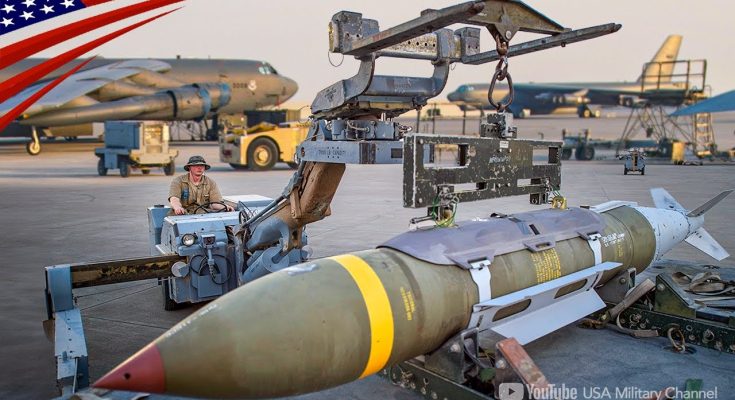The Boeing B-52 Stratofortress, one of the most iconic long-range, subsonic bombers in the world, has been a cornerstone of the U.S. Air Force for over six decades. Known for its incredible payload capacity and versatility, the B-52 is capable of carrying a wide range of ordnance, including some of the most powerful large smart bombs in the military’s arsenal. The aircraft is still in service today, having been extensively upgraded to stay relevant in modern warfare. When the B-52 loads and drops large smart bombs, it becomes a formidable force, capable of delivering precision strikes on high-value targets with devastating impact.
B-52 Stratofortress: An Overview
Originally designed in the 1950s as a strategic nuclear bomber, the B-52 has evolved into a versatile platform capable of performing a variety of missions, including conventional bombing, close air support, and intelligence gathering. It is capable of carrying an array of weapons, including nuclear bombs, precision-guided munitions, and conventional bombs. With its eight engines, large bomb bay, and a maximum payload capacity of 70,000 pounds, the B-52 is capable of carrying a diverse array of bombs, ranging from small precision-guided munitions (PGMs) to large, heavy bombs designed to destroy hardened targets or create massive blasts.
Large Smart Bombs: Precision and Power
One of the key factors that differentiate large smart bombs from conventional ordnance is their ability to strike with pinpoint accuracy, even when dropped from high altitudes or at long ranges. These bombs are equipped with advanced guidance systems, such as GPS or laser guidance, that allow them to hit specific targets with remarkable precision. The combination of size and smart guidance systems makes large smart bombs ideal for high-value target strikes, including bunkers, air defense systems, and infrastructure that would otherwise be difficult to neutralize with traditional bombing methods.
Two examples of large smart bombs that the B-52 is capable of carrying and dropping include the Joint Direct Attack Munition (JDAM) and the B61 nuclear bomb. While the JDAM is a conventional guided bomb, the B61 is a nuclear bomb equipped with a guidance kit, giving it both strategic and tactical capabilities.
Joint Direct Attack Munition (JDAM)
The JDAM is one of the most commonly used smart bombs in the U.S. Air Force arsenal. It can be attached to a wide variety of bombs, such as the MK-82, MK-83, and MK-84, converting them into precision-guided munitions capable of hitting targets with an accuracy of within a few meters. JDAM-equipped bombs are GPS-guided, and when dropped from the B-52 at high altitudes, they can strike targets with devastating precision even in poor weather conditions or at night.
B61 Nuclear Bomb
The B61 is a variable yield nuclear bomb that has been a cornerstone of the U.S. nuclear arsenal for decades. The B-52 can carry these bombs, which are equipped with guidance kits, allowing them to be dropped with greater accuracy compared to older free-fall bombs. These bombs are capable of penetrating hardened targets, such as bunkers or military command centers, with extreme effectiveness.
The B-52’s Role in Smart Bombing Operations
When the B-52 is tasked with dropping large smart bombs, the bomber’s crew relies on advanced targeting systems to guide the bombs to their targets. The B-52 is equipped with sophisticated avionics and targeting systems, such as the Radar Bomb Scoring System (RBSS) and the Northrop Grumman Navigation and Targeting System. These systems help ensure that the B-52’s crew can accurately guide smart bombs to their targets, even from hundreds of miles away.
During a mission, the B-52 may be tasked with dropping multiple large smart bombs on a variety of targets, either as part of a precision strike on critical infrastructure or as a counterforce attack in a large-scale conflict. The aircraft’s ability to carry a wide range of bombs allows for flexibility in mission planning, from soft target strikes to bunker-busting operations.
The Drop: Impact and Precision
Once the B-52 reaches its target area, the bombing run begins. The bomber flies at a specified altitude, often high above enemy defenses, to avoid detection and interception. The crew prepares to release the bombs, ensuring the targeting systems are locked onto the desired location. As the bomb doors open and the payload is released, the smart bombs are guided toward their target with high precision. Depending on the guidance system—whether GPS-based or laser-guided—the bombs will correct their flight path mid-air to hit the exact target.
The result is a highly effective strike capable of destroying enemy infrastructure, fortifications, or critical assets with minimal collateral damage. This is especially important in modern warfare, where precision and accuracy are paramount.
Conclusion
The B-52 Stratofortress, when equipped with large smart bombs, continues to be a critical asset in the U.S. Air Force’s arsenal. Its ability to carry a variety of precision-guided munitions allows it to perform strategic strikes with devastating accuracy. Whether delivering JDAMs on hardened targets or executing nuclear strikes with the B61, the B-52 remains a symbol of power and precision in modern warfare, capable of making an impact on the battlefield with each bomb dropped.



